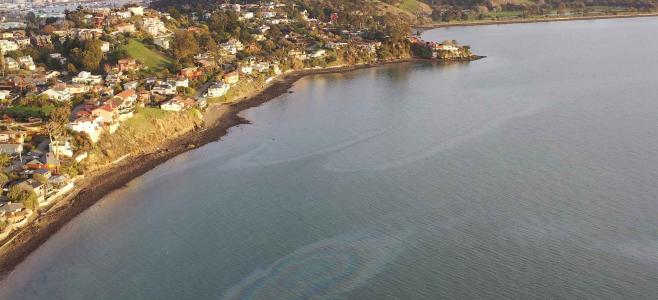 Found throughout North America, eelgrass is an important plant in estuaries like the San Francisco Bay because its structure creates multi-layered habitat for many organisms. Oil spills like the one that spread across Bay waters last week can devastate eelgrass beds and the marine life that they support.
Found throughout North America, eelgrass is an important plant in estuaries like the San Francisco Bay because its structure creates multi-layered habitat for many organisms. Oil spills like the one that spread across Bay waters last week can devastate eelgrass beds and the marine life that they support.
During an oil spill, eelgrass can be directly exposed at very low tides to oil slicks, which will readily stick to the eelgrass. Even when the eelgrass is submerged by the tides, thick globs of oil can form tar balls that sink to the bottom. Oil spills are also known to damage Pacific Herring eggs, potentially causing further harm to the struggling population. Just offshore of Crown Memorial Beach, the thirty-acre Alameda eelgrass bed could be exposed to oil from Friday’s spill. The Alameda eelgrass bed is an important spawning site for Pacific Herring and a critical "donor" bed for restoration efforts.
Eelgrass may look like seaweed, but it is actually a flowering plant that grows submerged in shallow water. Healthy eelgrass beds resemble terrestrial grasslands, only underwater. Their dense root system and tall leaf canopy provide food, cover and spawning ground for a wide array of invertebrates, fishes, birds and mammals. At its base, eelgrass roots hold sediment and important bacteria in place, which protects small invertebrates. These invertebrates are food for the fish and waterfowl that flock to eelgrass beds in droves to feast. The Pacific Herring is especially dependent on eelgrass beds. Every year from November through April, Pacific Herring spawn in the Bay, laying their sticky eggs on eelgrass leaves. When the young fish hatch, they can stay protected under the cover of the eelgrass until they reach maturity.
In recent years Bay Area biologists have put in a great effort to enhance existing eelgrass beds and restore this habitat to the fullest extent its range. Eelgrass is transplanted from a few resilient “donor” eelgrass beds to other sites of high restoration potential. The restoration team and Bay Area naturalists alike hope that their hard work will bring back this important habitat and reverse the Bay’s long-term decline in native biodiversity.
Unfortunately, the success of their efforts is still challenged by human activities in the Bay. Like all plants, eelgrass requires ample sunlight to grow. Dredging practices and shoreline construction, however, stir up sediments which cloud the Bay water and shade the eelgrass. Eelgrass beds are also at risk of physical damage by boats and dredging operations, and water pollution from land-based sources is a constant threat.


